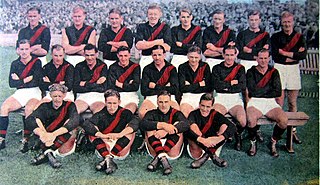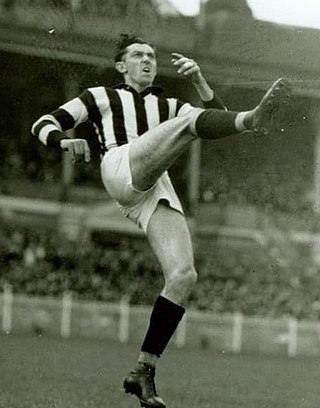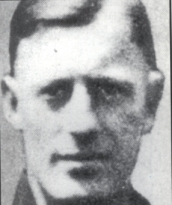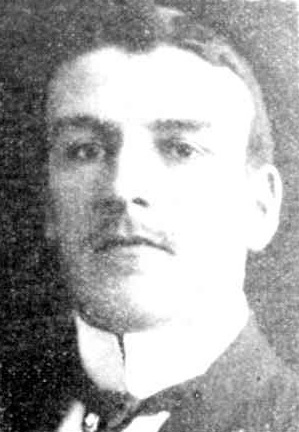
The Carlton Football Club, nicknamed the Blues, is a professional Australian rules football club based at Princes Park in Carlton North, an inner suburb of Melbourne in Victoria, Australia. The club competes in the Australian Football League (AFL), the sport's premier competition.

The Collingwood Football Club, nicknamed the Magpies or colloquially the Pies, is a professional Australian rules football club based in Melbourne, Victoria that competes in the Australian Football League (AFL), the sport's elite competition. Founded in 1892 in the Melbourne suburb of Collingwood, the club played in the Victorian Football Association (VFA) before joining seven other teams in 1896 to form the breakaway Victorian Football League (VFL), known today as the Australian Football League (AFL). Originally based at Victoria Park, Collingwood now plays home games at the Melbourne Cricket Ground and has its headquarters and training facilities at Olympic Park Oval and the AIA Centre.

John Vincent Regan was an Australian rules footballer who represented Collingwood in the Victorian Football League (VFL) during the 1930s and 1940s.

The AFL Grand Final is an Australian rules football match to determine the premiers for the Australian Football League (AFL) season. Prior to 1990 it was known as the VFL Grand Final, as the league was then known as the Victorian Football League, and both were renamed due to the national expansion of the competition. Played at the end of the finals series, the game has been held annually since 1898, except in 1924. It is traditionally staged on the afternoon of the last Saturday in September, at the Melbourne Cricket Ground. As the premier match of the AFL season, it attracts one of the largest audiences in Australian sport, regularly attracting a crowd of more than 100,000 and a television audience of millions.

In England, Australian rules football is a team and spectator sport with a long history. It is home to the longest running Australian rules fixture outside Australia, the match between Oxford and Cambridge Universities which has been contested annually since 1923. All other current competitions originated in 1989 with the founding of what is now AFL London, the longest running Australian rules football league in Europe. The current governing body, AFL England, was formed in 2012 and expanded the game in 2018 to include the additional regional divisions: AFL Central & Northern England and AFL Southern England.

The 1950 VFL season was the 54th season of the Victorian Football League (VFL), the highest level senior Australian rules football competition in Victoria. The season featured twelve clubs, ran from 22 April until 23 September, and comprised an 18-game home-and-away season followed by a finals series featuring the top four clubs.
The 1928 VFL season was the 32nd season of the Victorian Football League (VFL), the highest-level senior Australian rules football competition in Victoria. The season featured twelve clubs and ran from 21 April to 29 September, comprising an 18-match home-and-away season followed by a four-week finals series featuring the top four clubs.

Ronald Walford Todd was an Australian rules footballer who played for the Collingwood Football Club in the Victorian Football League (VFL) and the Williamstown Football Club in the Victorian Football Association (VFA). Renowned for his high marking and goalkicking ability, Todd was considered as the logical successor to the legendary Gordon Coventry, but his controversial move to Williamstown, along with teammate and friend Des Fothergill, caused much bitterness at Collingwood for many years afterward. He holds the record for the most goals kicked in a VFA season (188), and his 23 goals in the 1939 VFL finals series stood as a record until it was broken by Gary Ablett Sr. in 1989.
Thomas Joseph Corrigan was an Australian rules footballer who played for Fitzroy in the Victorian Football League (VFL), and Nothcote in the VFA during the 1920s and 1930s. He died of peritonitis that had been mis-diagnosed as influenza by a RAAF doctor whilst serving in the RAAF during the Second World War.

James Jackson was an Australian rules footballer who played with the St Kilda Football Club and the Collingwood Football Club in the Victorian Football League (VFL), and with the Hawthorn Football Club in both the Victorian Football Association (VFA) and the VFL.
The 1930 VFL grand final was an Australian rules football game contested between the Collingwood Football Club and Geelong Football Club, held at the Melbourne Cricket Ground in Melbourne on 11 October 1930. It was the 32nd annual grand ginal of the Victorian Football League, staged to determine the premiers for the 1930 VFL season. The match, attended by 45,022 spectators, was won by Collingwood by a margin of 30 points. It was the club's ninth premiership victory and fourth in succession. As of 2023, Collingwood is the only team in VFL/AFL history to win four consecutive premiersips.

George Frederick "Ted" Regan was an Australian rules footballer who played for Melbourne and Essendon in the Victorian Football League (VFL).

Wilfred George Atkinson was an Australian rules footballer who played with Carlton in the Victorian Football League (VFL). He enlisted in the Royal Australian Air Force during World War II, and was killed in action when his bomber was shot down over the Aegean Sea in 1943. He was serving as a Pilot Officer in No. 232 Squadron RAF.
James Alexander Nash was an Australian rules footballer who played for the Hawthorn Football Club in the Victorian Football League (VFL).

Lance Kitchener Collins was a leading Australian rules footballer of the 1940s, playing for Carlton Football Club in the Victorian Football League (VFL).

Maurice Ignatius Collins was an Australian rules footballer who played for Essendon in the Victorian Football League (VFL).
The 1928 VFL Grand Final was an Australian rules football game contested between the Collingwood Football Club and Richmond Football Club, held at the Melbourne Cricket Ground in Melbourne on 29 September 1928. It was the 30th annual Grand Final of the Victorian Football League, staged to determine the premiers for the 1928 VFL season. The match, attended by 50,026 spectators, was won by Collingwood by a margin of 33 points, marking that club's seventh premiership victory and second in succession.

Herbert Charles Dummett was an Australian rules footballer who played with Collingwood in the Victorian Football League (VFL).

Edward Henry Ryan was an Australian rules footballer who played with the Williamstown Football Club in the Victorian Football Association (VFA) and the Collingwood Football Club in the Victorian Football League (VFL).
William Ambrose Spokes was an Australian rules footballer who played with Fitzroy in the Victorian Football League (VFL), and with Preston, Brunswick, and Williamstown in the Victorian Football Association (VFA).
















